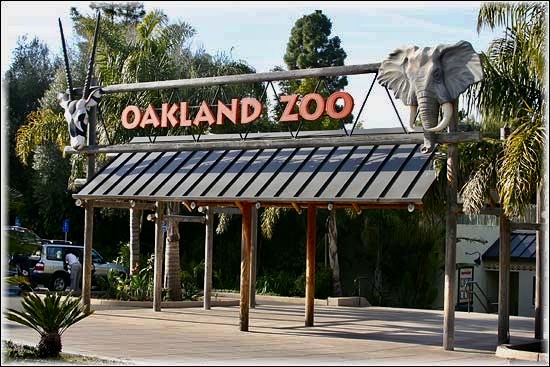Once upon a time, a female elephant called Effie lived at the then-downtown Oakland Zoo. Effie was used to watching the owner’s family stroll on the grounds, so one day, she did what she saw them do, she helped push the baby’s buggy.
The zoo of the 1950s is incomparable to the one of the 2020s. First, it was privately owned, after a landowner met a naturalist’s dream to create a small zoo. At the time, the owner’s house stood among the animal pens. In those days, zoos were populated by capturing animals in Africa and, truth be known, the resident bear had been lassoed in the Arctic.
The animals were put to work by providing entertainment for all ages. Parades, for example, were a mixed tradition of circus and zoo. Unconceivable today, the tiger would ride on a platform fitted to the donkey’s back. And Effie would play the harmonica.
Today, the zoo spreads in the hills above Oakland, in the San Francisco Bay Area. Children see the animals in a natural environment and can visit the modern veterinary hospital that treats miniature frogs as well as elephants. It also offers global conservation and education programs, all of which require a substantial, and sustainable, budget.
2022 – The Year of the Tiger
Since Effie’s time, the ethics about animals in captivity have changed, and managing a zoo has become a challenging commitment. The idea is still controversial, in part because of the reprehensible living conditions in many of the zoos and circuses of the past, and those that are still escaping scrutiny today.
As I ponder a tiger sound asleep, I am reminded of an encounter many years ago as we were overnighting at the only accommodation available on a road trip. I thought I was hallucinating when I came face to face with a tiger tied to a tree outside the window of our ground-floor room. I had never been so close to a tiger! It was obvious from the long truck in the parking lot that the enslaved animal was the partner of a traveling ‘artist.’
As I walk by some of the habitats of the 45-acre Oakland Zoo, I consider the plight of tigers and the role of today’s zoos in keeping them from extinction. I didn’t see any tigers on a tiger-sighting tour in Ranthambore National Park, in India. Habitat destruction and illegal trade are two of the reasons that put wild tigers on the path to extinction.
Today, animal rights organizations do their best to get unsuitable facilities closed. Reputable zoos operate in a natural-seeming environment, with adequate enclosures, and facilities allowing animals to live in social groups.
According to the World Wildlife Organization, 95 percent of tigers had died by the start of the 21st century. Today, there are 3,900 tigers in captivity in the United States, and as few as 3,200 tigers in the wild, worldwide. The fate of this specie—whether it will become extinct or not—in part depends on zoos with breeding programs.
Safari at the Oakland Zoo
I am pushing my grandson’s stroller in a vast open area. It feels so natural that we haven’t noticed the Vervet monkeys going about their daily business in the trees along the path. When they shriek and bark, we stop to watch and listen.
Down the path, we get a glimpse of squirrel monkeys chasing each other. As for the chimpanzees, they watch us watching them, perhaps with their own judgment of us, visitors.
We trek uphill to the African veldt of the giraffes where a bench conveniently welcomes us. Like us, the animals are thirsty. My grandson gets a kick as the tallest of all animals bends its rear legs and graciously bows toward the water. As for feeding, do they eat leaves on tall trees because of their long necks, or were their legs created for that purpose? Their ability to get a simple drink of water seems a bit of a “creation miss.” Her life at the zoo must be somewhat satisfying, judging by the calf at her side.
Close by, two of the Big Five animals—as safari tour operators call them—enjoy space and quiet. One elephant seems to meditate while a lion rises on the reconstituted cliff of its own enclosure, seemingly ready to address the animal kingdom. Other big cats snooze in the shade of trees.
I smile at a camel. I have always been fond of their haughty impassivity and caterpillar-like eyelashes. Despite the company of three females, this male looks rather bored, but who knows? As for the zebras, they always seem ready for a fun event with their attention-getting black and white stripes.
At the Wayne and Gladys Valley Children’s Zoo, my grandson gets so excited that he gets off his stroller. The real animals were out of reach, and not as inviting as the fake giant red frog he toddles to. He smiles at goats, rabbits, sheep, and other domestic animals, but the alligators get a suspicious look. Never mind, we end our visit on the Outback Express train, for a quick tour of Australia.
Zoos as Refuges and Inspiration
Like humans who are displaced by conflicts or natural disasters and need refuge, so do animals. The Oakland Zoo provides care, rehabilitation, and sanctuary. They also lobby to enact laws that protect wildlife and prevent the exploitation of captive animals. And they inspire a younger generation with summer internships to encourage careers in ecology, and leadership.
Today, a new generation of elephants, Lisa, Donna, and Osh, enjoy six acres of roaming grounds, with a pool. Effie would be impressed.
Messages (edited)
Delbert Greer says, March 1, 2013
Hi, I don’t think Effy is as old as you think. When I was little, 5 or so, my mom and dad took me to the Oakland Zoo, and it was as you said. The animals were in cages more than pens with bars and you could get way too close. Effy was in a really big cage with just bars. You could get a peanut and give it right to her trunk. And I did have an eye to eye with her when she took my hand with her trunk and held it, not hard. It did not hurt but she was saying look at me. I did. And I did not get as close again. But I always loved to see her as we went back every few years. And it was odd that she would always give me the time and stay as long as I was by her cage. I wonder if she would remember me now as I do her. Oh, yeah, they never forget.
Marie-Claude Arnott says, March 1, 2013
Thank you for your interest and for your comments. How nice that you got to meet Effie! I don’t know how old the young elephant was when she arrived in Oakland, but since it was in 1958, you are right: the early 1900s was too early a time for her to push the buggy at the zoo. It should have read the mid-1900s. Good point!
(Zoom to enlarge the photos)

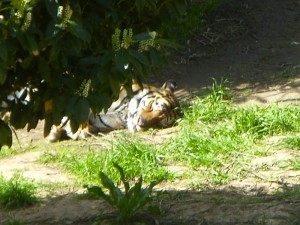
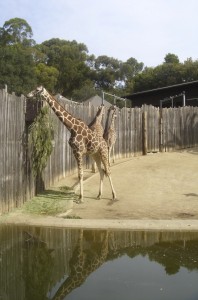
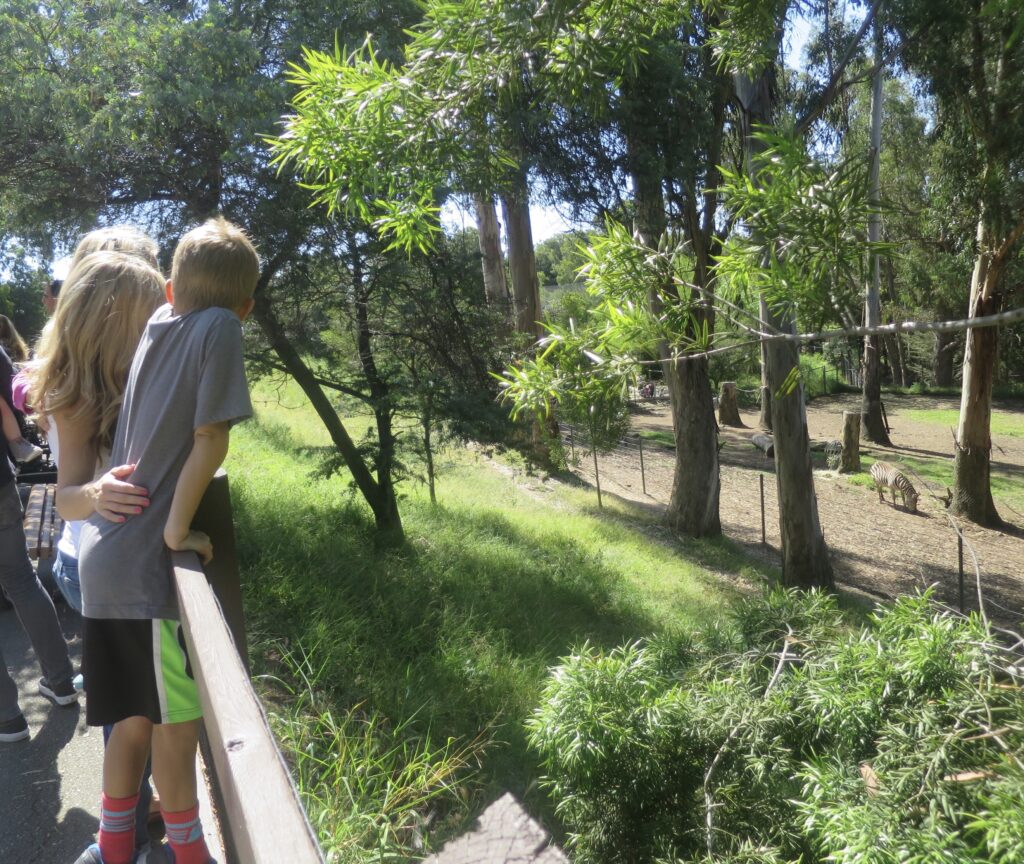
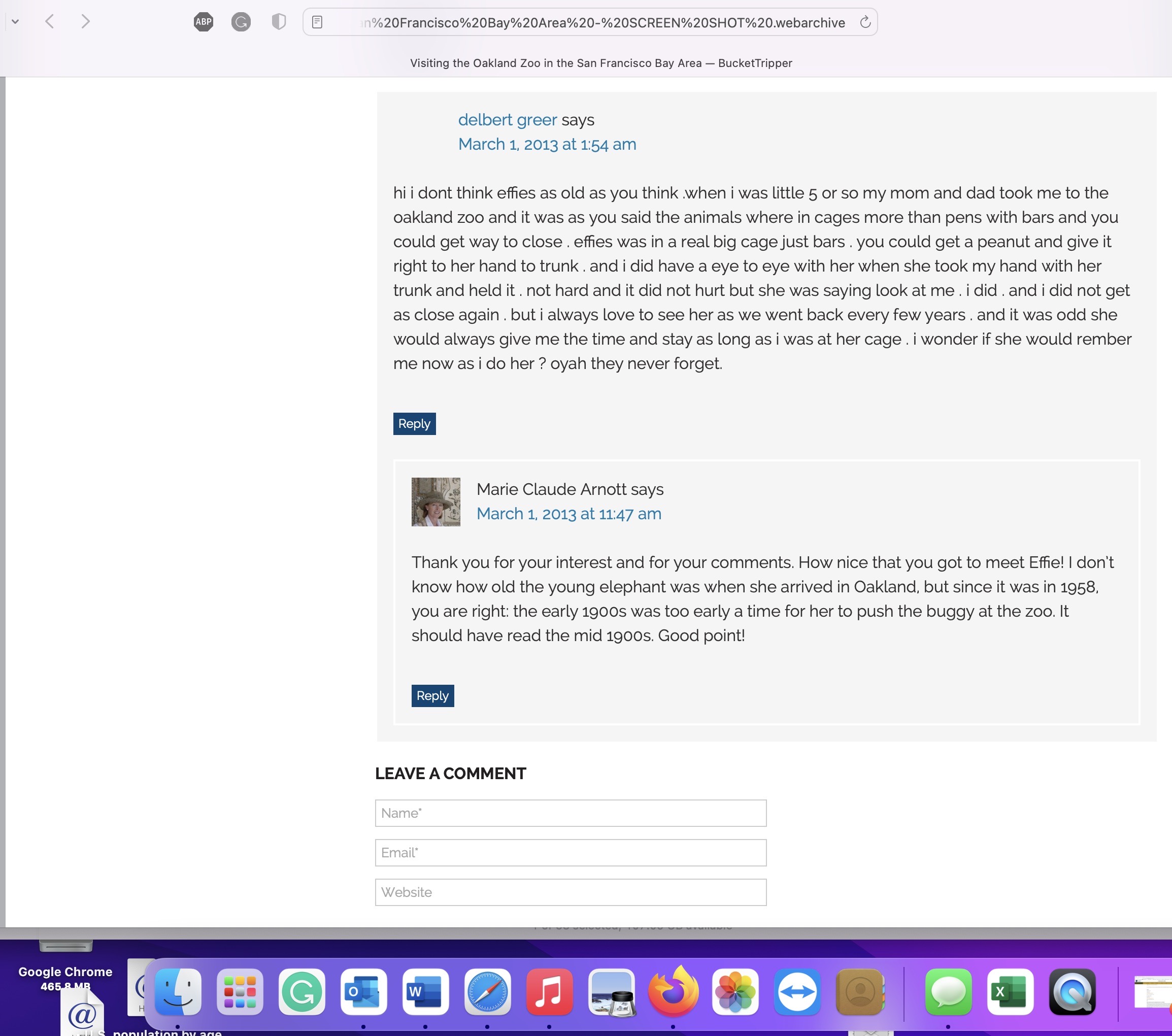
Original article 2013 Buckettripper – Revised 2022

